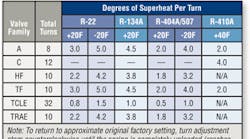Q: What is superheat?
Superheat refers to the number of degrees a vapor is above its saturation temperature (boiling point) at a particular pressure.
Q: How do I measure superheat?
Superheat is determined by taking the low side pressure gauge reading, converting that pressure to temperature using a PT chart, and then subtracting that temperature from the actual temperature measured (using an accurate thermometer or thermocouple) at the same point the pressure was taken.
Q: Why is it important to know the superheat of a system?
Superheat gives an indication if the amount of refrigerant flowing into the evaporator is appropriate for the load. If the superheat is too high, then not enough refrigerant is being fed, resulting in poor refrigeration and excess energy use. If the superheat is too low then too much refrigerant is being fed possibly resulting in liquid getting back to the compressor and causing compressor damage.
Q: When should I check the superheat?
The superheat should be checked whenever any of the following take place:
- System appears not to be refrigerating properly
- Compressor is replaced
- TXV is replaced
- Refrigerant is changed or added to the system
Note: The superheat should be checked with the system running at a full load, steady state condition.
Q: How do I change the superheat?
Turning the adjustment stem on the TXV:
Clockwise - increases the superheat
Counter clockwise - decreases the superheat. (See table).
Note: To return to approximate original factory setting, turn adjustment stem counterclockwise until the spring is completely unloaded (reaches stop or starts to ‘ratchet’). Then turn it back in 1/2 the ‘Total Turns’ shown on the chart.
©2009 Emerson Climate Technologies, Inc. All rights reserved. Used by permission.










